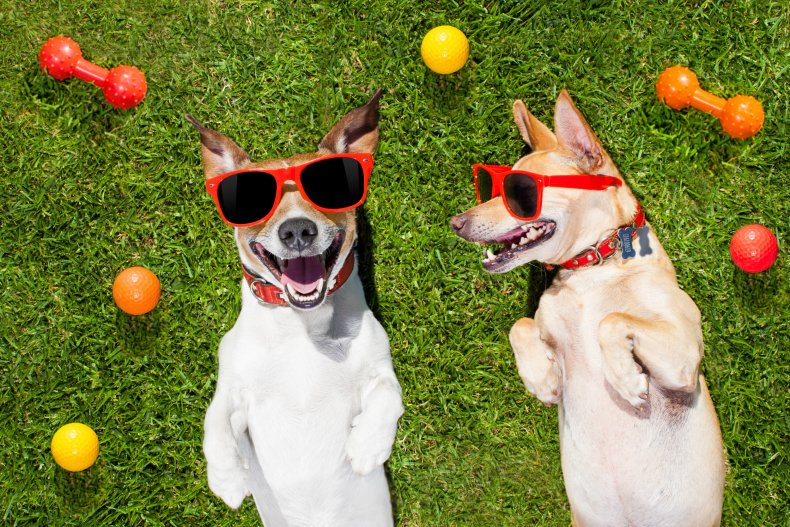Are Dogs Color Blind?
Dogs perceive colors differently than the way humans do because of how their eyes are built. But are dogs color blind? The answer isn't entirely black and white.
Speaking to Newsweek, Dr. Jerry Klein, a veterinarian who is the chief veterinary officer at the American Kennel Club (AKC), said a dog's color perception is limited by the number of cones they have. Cones are nerve cells in the eye that help differentiate colors. "Each type of cone connects with a different light wavelength."
Humans and a few other primate species are "trichromatic," Klein explained, which means their eyes have three types of cones. "Dogs are dichromatic, and only have two types."
Klein said human eyes have a cone for red and green, which gives them the ability to see a red rose or a Granny Smith apple.
"Dogs, and some color-blind people, are missing the red-green cones. Dogs can see yellow and blue, and a combination of those hues. This means they see a lot of the world as grayish-brown," Klein told Newsweek.

In an article published by the VCA, one of North America's largest animal hospital chains operating more than 1,000 veterinary practices across the U.S., Canada and Japan, veterinarian Dr. Lynn Buzhardt wrote: "While dogs can't appreciate all the colors that humans do, their world is not entirely black and white. In fact, dogs live in a pretty colorful world."
Buzhardt says: "When it comes to distinguishing color, a dog's normal vision is most like a person who has red-green colorblindness. Having said that, no further degrees of colorblindness have been recorded in dogs."
What Is Color Blindness?
Color blindness is the inability to differentiate between colors. The U.S. National Eye Institute explains: "If you have color blindness, it means you see colors differently than most people. Most of the time, color blindness makes it hard to tell the difference between certain colors."
Those who are color blind find it hard to see how bright colors are as well as different shades of colors.
The most common type of color blindness is one where you're unable to differentiate between red and green. Another type makes it difficult to tell the difference between yellow and blue, the NEI says.

What Colors Can Dogs See?
In an article for PetMD, a pet information website, Florida based veterinarian Dr. Christina Fernandez wrote: "Research leads us to believe that dogs see the world through a unique color spectrum," with blue and yellow being the dominant colors of a dog's vision range.
Dogs are "very good at distinguishing between variations of blues and yellows, but cannot really see red and green all that well," Fernandez explained.
Blue, blue-green, and violet will be perceived as different shades of blue. Different shades of red and green "probably look more like browns and grayscale to a dog," Fernandez adds.
The AKC says this may explain why dogs might get excited when playing fetch with a yellow tennis ball but are not as responsive when using the same ball in a red or green color.
Dogs are also less sensitive to changes in brightness, which makes them unable to see color in the vibrant, rich tones that humans perceive, Buzhardt explains.

Other Visual Capabilities of Dogs
While humans have more cones, dogs have more rods in the retina of their eyes. Rods are "extremely sensitive cells that catch movement," Klein told Newsweek.
Dog eyes have larger lens and corneal surface and a "reflective membrane known as tapetum," which enhances their night vision. The rods in their retina improves low-light vision, Klein said.
Rods help detect "even small movements at great distances," Buzhardt explains. "So, when compared to humans, dogs see better in dim light (dusk and dawn) and can more accurately detect motion."
Buzhardt also says dogs are more near-sighted than humans. This means an object that appears in focus and clear to a human at a certain distance may look blurry to dogs from the same distance.

Why Do Dogs Have Enhanced Visual Abilities?
Much of it is down to evolution and nature. Dogs are naturally adapted to see better in low light and more accurately detect movement as it makes them better hunters by night and helps them survive in the wild.
Klein told Newsweek: "Dogs developed their senses as nocturnal hunters, tracking and catching their food at night. Therefore, their eyes adapted to see well in the dark and to catch movement."
Buzhardt says: "Seeing well in dim light and picking up slight movements in the forest at great distances improve the dog's hunting ability. These assets also help a dog know when HE is the prey and needs to flee."
Newsweek has contacted the American Veterinary Medical Association and the American Animal Hospital Association for further comment.


